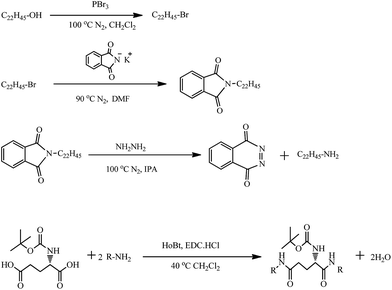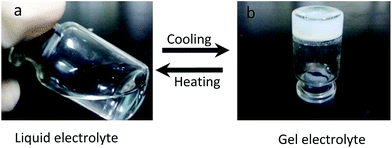Glutamic acid derivatives as gelators for electrolyte of lithium ion batteries
Liping Li,
Qiuxia Zhang,
Hong Huo,
Jianjun Zhou* and
Lin Li*
Beijing Key Laboratory of Energy Conversion and Storage Materials, College of Chemistry, Beijing Normal University, Beijing 100875, China. E-mail: pla_zjj@bnu.edu.cn; lilinll@bnu.edu.cn
First published on 26th August 2016
Abstract
Organic gelators of glutamic acid derivative were synthesized, which have been successfully used to gel commercial electrolyte for lithium ion battery. The organic gelators self-assembled to form 3D fibrillar structures with very high porosity in the electrolyte solvent. Thermal stability of the gel electrolyte increased with the length of side chain and concentration of gelators. When the side chain length of gelator was 22 carbons, the gel electrolyte could endure temperature higher than 60 °C with the addition 2 wt% gelator. The most prominent advantage of gel electrolyte over liquid electrolyte was that it could broaden the electrochemical stable window, which has potential application in high voltage lithium ion batteries. With the addition of organic gelator, conductivity of the gel electrolyte would decrease a little, but it still showed the conductivity–temperature behavior of liquid electrolyte. The cells with gel electrolyte showed similar cycling performance as those with liquid electrolyte, which indicated that the organic gelators of glutamic acid derivatives could be used in lithium ion batteries, especially in high voltage lithium ion batteries.
1. Introduction
Currently, energy crisis and environmental problems have attracted great attention due to the fast exhaustion of fossil energy, global warming and the frequent onset of heavy haze in big cities due to the massive automotive exhaust emissions. Electric energy is a kind of clean energy that can be repeatedly used by the rechargeable battery. Lithium ion battery is one of the best choices of rechargeable batteries due to its high voltage plateau, high energy density, long cycling life, no memory effect and low self-discharge.1 Wide application has been found not only in portable electronics, such as cell phones, digital cameras, pads and laptop computers, but also in power applications, such as electric tools, electric vehicles etc., in recent years. However, potential safety problems, such as being inflammable and explosive have limited its further development.2,3 The safety of lithium ion battery is related to the cathode and anode material,4–8 separator9,10 and liquid electrolyte.11 The liquid electrolyte is volatile and takes part in almost all processes of electrochemical reaction. The volatile liquid electrolyte is one of the key factors that restrict the safety of lithium ion battery due to its leakage, inflammability and over voltage decomposition etc.12–14To make up for the shortcomings of leakage and inflammability of liquid electrolyte, inorganic solid electrolyte, polymer solid electrolyte and gel polymer electrolyte have been studied. Inorganic solid electrolyte is a type of lithium ion containing inorganic super ion conductivity or amorphous lithium ion containing glass.15,16 Polymer solid electrolyte is a lithium ion, and its conductivity is mostly based on polyethylene oxide (PEO) and lithium salt.17 The inorganic solid electrolyte and polymer solid electrolyte do not contain inflammable liquid electrolyte, which can improve the safety performance of lithium ion batteries. However, the conductivity of most solid electrolytes is still too low, which affects the cycle performance of the battery.
Gel polymer electrolyte is prepared by adding gel polymer to liquid electrolyte, which has the conductivity of liquid electrolyte.18–22 The liquid electrolyte containing a porous gel polymer network, can inhibit leakage and overflow. Since gel polymer electrolyte has the conductivity of liquid electrolyte, a lot of gel polymers, such as PEO,17,18 polyvinylidene fluoride,19 polymethylmethacrylate,20,21 polyacrylonitrile22 etc. have been widely reported. Porous polymer web or film is obtained by electrospinning or phase inversion method to prepare the gel polymer electrolyte.
Apart from gel polymer, some organic gelators were also reported to gel liquid electrolyte component of lithium ion battery. The organic gelators form 3D porous network by self-assembling in the liquid electrolyte through inter-molecular interactions such as hydrogen bond, π–π stacking, van der Waals force etc.23–25 For example, Kubo et al., reported a gelator of amino acid derivative, which could be used to prepare quasi-solid-state electrolyte in dye-sensitized solar cells.26 Huo et al., used tetradodecylammonium bromide as an organic gelator to fabricate the quasi-solid-state dye-sensitized solar cell with higher initial energy conversion efficiency.27 Sun et al., synthesized a new low molecular weight gelator with D-sorbitol and 3,4-dimethyl-benzaldehyde, which formed gel in super capacitors, and showed very good cycling performance.28 Basrur et al., combined a small-molecule organic gelator (1,3:2,4-di-O-methyl-benzylidene-D-sorbitol, MDBS) with fumed silica to prepare gel electrolyte with LiClO4/propylene carbonate electrolyte.29 The gel electrolyte, which had high ionic conductivity and wide electrochemical stability window, was strong enough to behave as a free-standing, dimensionally stable solid.
Although the organic gelators can gel the liquid electrolyte component, none of the reported organic gelators can gel the commercial liquid electrolyte for lithium ion battery. In this manuscript, the aim is to synthesize an organic gelator, which can directly gel the commercial liquid electrolyte for lithium ion battery, and investigate whether the organic gelator is feasible to use in lithium ion battery. Since organic gelators self-assemble in the liquid electrolyte to form a porous 3D network, there is no need to prepare porous web as that of gel polymer, which will provide a more convenient way to prepare gel electrolyte and corresponding gel lithium ion battery.
2. Experimental
2.1 Materials
N-Boc-D-glutamic acid, cetylamine, octadecylamine, docosanol were purchased from Aladdin Industrial Corporation. CH2Cl2, tetrahydrofuran (THF), N,N-dimethylformamide (DMF) etc., were purchased from Beijing Chemical Works. All gelators were dried under vacuum for 24 h at 60 °C before adding into the electrolyte.2.2 Synthesis
The target compounds were synthesized according to Scheme 1.1-Bromodocosane (160 g, 41 mmol) and potassium phthalimide (83.7 g, 45 mmol) were dissolved in DMF, and reacted at 90 °C under N2 protection for 8 h. After removing DMF by rotary evaporation, the crude product was washed with water and dried in vacuum at 60 °C. The yield was 91.39%.
The above product (50 g, 11 mmol) and hydrazine hydrate (20 mL, 33 mmol) were dissolved in isopropyl alcohol (IPA). After bubbling with N2 for 30 min, the mixture was refluxed at 100 °C for 4 h under N2 protection. The crude product was obtained by filtration and dried in vacuum. Finally, the crude product was further recrystallized in ethanol to get pure 1-docosylamine, and the yield was 68.5%.
The final synthesis and purification method of G-22 was same as G-16 and G-18 with boc-D-glutamic acid (1.2 g, 5 mmol) and 1-docosylamine (3.6 g, 11 mmol), and the yield was 81.2%. 1H NMR (CDCl3): δ (ppm) = 6.60 (s, 1H), 6.15 (s, 1H), 5.73 (s, 1H), 4.08 (s, 1H), 3.24 (m, 4H), 2.33 (m, 2H), 2.04 (m, 2H), 1.50 (m, 4H), 1.44 (s, 9H), 1.25 (m, 76H), 0.88 (t, 6H).
2.3 Preparation and characterization
The dried gel samples for scanning electronic microscopy (SEM) were prepared by adding a certain amount of gelator in the EC and DMC mixed solvent (1![[thin space (1/6-em)]](https://www.rsc.org/images/entities/char_2009.gif) :
:![[thin space (1/6-em)]](https://www.rsc.org/images/entities/char_2009.gif) 1, v/v) and heated with constant stirring until they completely dissolved. After gradually cooling it to room temperature and keeping for 8 h, the gel samples were dried by lyophilizer for 48 h to ensure that all solvents had been removed completely.
1, v/v) and heated with constant stirring until they completely dissolved. After gradually cooling it to room temperature and keeping for 8 h, the gel samples were dried by lyophilizer for 48 h to ensure that all solvents had been removed completely.
The gel electrolyte was prepared in the argon-filled glove box. Certain amount of gelator was added into the liquid electrolyte, and the mixture was heated with constant stirring until the gelator completely dissolved. Gel electrolyte was obtained by gradually cooling to room temperature and keeping it for 8 h.
The gel-to-solution (TGS) transition temperature of the gel electrolyte was measured by differential scanning calorimetry (DSC) (Perkin Elmer DSC8000). The samples were prepared by dropping the hot gel electrolyte solution into DSC liquid crucibles in argon-filled glove box, and letting it stand for 8 h to gel. The liquid crucibles were sealed and scanned at a rate of 5 °C min−1 under nitrogen in the temperature range of 10–80 °C (TGS).
2.4 Electrochemical properties
Linear sweep voltammetry (LSV) was used to determine the electrochemical stability window of the gel electrolyte using a simple mould with stainless steel (SS) as the working electrode and Li foil as the counter electrode. A voltage sweep between 3.0 V to 6.5 V was carried out at a constant scan rate of 1 mV s−1.The ionic conductivity of the gel electrolyte was measured by electrochemical impedance spectroscopy (EIS) using a SS/gel/SS mould, over the frequency range from 1 Hz to 1 MHz with an AC signal at the amplitude of 10 mV. The high frequency impedance value gives the bulk resistance of the gel electrolytes (Rb), from which the ionic conductivity of the gel electrolyte (σ) was calculated with the relation: σ = L/(S × Rb), where, L is the distance between the two stainless steel electrodes and S is the active surface area.
The charge/discharge cycling performance of lithium ion battery with gel electrolyte was measured on a cell testing system (CT2001A LanHe, Wuhan Land Electronics Co., Ltd., China). CR2032 coin-type half cells were assembled with lithium foil as anode and LiCoO2 as cathode. A commercial electrolyte was used, which was 1 M LiPF6 in ethylene carbonate![[thin space (1/6-em)]](https://www.rsc.org/images/entities/char_2009.gif) :
:![[thin space (1/6-em)]](https://www.rsc.org/images/entities/char_2009.gif) dimethyl carbonate (EC
dimethyl carbonate (EC![[thin space (1/6-em)]](https://www.rsc.org/images/entities/char_2009.gif) :
:![[thin space (1/6-em)]](https://www.rsc.org/images/entities/char_2009.gif) DMC) (1
DMC) (1![[thin space (1/6-em)]](https://www.rsc.org/images/entities/char_2009.gif) :
:![[thin space (1/6-em)]](https://www.rsc.org/images/entities/char_2009.gif) 1 v/v, Shenzhen Biyuan electronics Co., Ltd., China). The gelator was added into the electrolyte under stirring to obtain uniform electrolyte slurry first. While assembling, the electrolyte slurry was added into the half cells instead of common liquid electrolyte. After assembling, the cells were heated to 80 °C for 5 min to dissolve the gelator into the liquid electrolyte first. Then, they were gradually cooled to room temperature and kept for 8 h to obtain gel electrolyte.
1 v/v, Shenzhen Biyuan electronics Co., Ltd., China). The gelator was added into the electrolyte under stirring to obtain uniform electrolyte slurry first. While assembling, the electrolyte slurry was added into the half cells instead of common liquid electrolyte. After assembling, the cells were heated to 80 °C for 5 min to dissolve the gelator into the liquid electrolyte first. Then, they were gradually cooled to room temperature and kept for 8 h to obtain gel electrolyte.
3. Results and discussion
3.1 Morphology
The glutamic acid derivatives (G-16, G-18 and G-22) could dissolve in both carbonate solvent and commercial liquid electrolyte for lithium ion battery when heated to certain temperatures, as shown in Fig. 1a. As the mixture gradually cooled to room temperature, the glutamic acid derivatives self-assembled in the solution and the gel was formed, as shown in Fig. 1b. So the glutamic acid derivatives (G-16, G-18 and G-22) could be used as gelator for commercial liquid electrolyte.The self-assembled gel morphology of G-18 in a mixed solvent (EC![[thin space (1/6-em)]](https://www.rsc.org/images/entities/char_2009.gif) :
:![[thin space (1/6-em)]](https://www.rsc.org/images/entities/char_2009.gif) DMC = 1
DMC = 1![[thin space (1/6-em)]](https://www.rsc.org/images/entities/char_2009.gif) :
:![[thin space (1/6-em)]](https://www.rsc.org/images/entities/char_2009.gif) 1, v/v) is shown in Fig. 2. At low concentrations, G-18 self-assemble to form interwoven 3D fibrillar structures with high porosity, as shown in Fig. 2a and b which is the typical morphology of gel. As the concentration increased, the morphology changed from fibrillar to lamellar structure with high porosity, as shown in Fig. 2c and d.
1, v/v) is shown in Fig. 2. At low concentrations, G-18 self-assemble to form interwoven 3D fibrillar structures with high porosity, as shown in Fig. 2a and b which is the typical morphology of gel. As the concentration increased, the morphology changed from fibrillar to lamellar structure with high porosity, as shown in Fig. 2c and d.
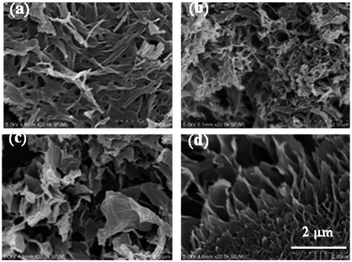 | ||
Fig. 2 Morphology of gel with (a) 2 wt%, (b) 4 wt%, (c) 6 wt%, (d) 8 wt% G-18 in mixed solvent (EC![[thin space (1/6-em)]](https://www.rsc.org/images/entities/char_2009.gif) : :![[thin space (1/6-em)]](https://www.rsc.org/images/entities/char_2009.gif) DMC = 1 DMC = 1![[thin space (1/6-em)]](https://www.rsc.org/images/entities/char_2009.gif) : :![[thin space (1/6-em)]](https://www.rsc.org/images/entities/char_2009.gif) 1, (v/v)). 1, (v/v)). | ||
3.2 Thermal stability of the gel electrolyte
The TGS is used to characterize the thermal stability of gel electrolyte. Below TGS, the gel electrolyte is in gel state. Above TGS, the self-assembled network collapses, and the gel electrolyte changes into solution state. DSC heating curves of gel electrolyte with 2 wt% gelators are shown in Fig. 3a. It was found that the TGS increased with alkyl chain length. TGS were 44 °C, 55 °C and 61 °C, respectively, for G-16, G-18 and G-22 gel electrolytes. The increase of alkyl chain length led to higher TGS. Longer chain length was contemplated to have increased the entanglement of the side chains, and the intermolecular van der Waals interaction to have strengthened. Therefore, the highest temperature was needed to destroy the self-assembled structures for G-22 gel electrolyte. The effect of gelator concentration on TGS was also studied as shown in Fig. 3b. TGS slightly increased as the concentration of the gelator was raised from 2 wt% to 6 wt%. The trend with concentration was reasonable, since higher concentration would lead to stronger intermolecular interaction force between the gelator and solvent.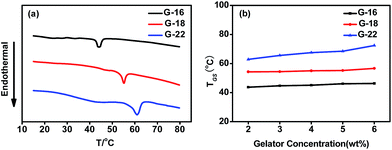 | ||
| Fig. 3 (a) DSC heating curves of gel electrolytes with 2 wt% gelator, (b) TGS changes with gelator concentration. | ||
3.3 Electrochemical properties of the gel electrolyte
The electrochemical stability window is very important for the electrolyte, because it determines the highest operating potential of battery. The LSV current undergoes a sharp increase when the free solvent components in the electrolyte, such as EC and DMC, begin to decompose. The corresponding decomposition voltage is the upper operating limit. Fig. 4 showed the LSV curves of liquid electrolyte and gel electrolytes with 2 wt% gelator. The decomposition voltage of liquid electrolyte was about 5.03 V vs. Li/Li+, whereas the decomposition voltage of gel electrolyte with gelators was much higher and reached about 5.85 V vs. Li/Li+. The improvement of about 0.82 V of the decomposition voltage was obtained when the liquid electrolyte became gel with the addition of 2 wt% gelator. The gel state of the electrolyte should be responsible for the improvement. In gel electrolyte, 3D skeleton network of the gelator formed, which should affect the ion transfer and activity of the free solvent components. The restriction on the movement and activity of the free solvent would result in the improvement of the decomposition voltage.31 Currently, one of the main efforts for lithium ion batteries is the development of high voltage cathode materials, which require corresponding electrolyte with higher decomposition voltage.32 Obvious improvement of the decomposition voltage demonstrates that our gel electrolyte may have potential advantage for high voltage lithium ion battery.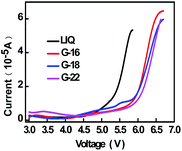 | ||
| Fig. 4 Linear sweep voltammetry of gel electrolyte with 2 wt% gelator in liquid electrolyte, LIQ: liquid electrolyte. | ||
EIS is a powerful technique to measure the ionic conductivity of an electrolyte. In an impedance spectrum, the line at low frequency shows the capacitive behavior and the point of intersection with the real axis at high frequency shows the resistance of ionic transport.33 The ionic conductivity of liquid electrolyte and gel electrolyte are shown in Fig. 5a. Compared with the liquid electrolyte, the ionic conductivity of gel electrolyte with 2 wt% gelator decreased slightly. It was found that gelator with longer alkyl chain length would lead to smaller ionic conductivity of the gel electrolytes. For example, the ionic conductivity of the liquid electrolyte was 11.07 mS cm−1, while the ionic conductivity of gel electrolyte was 9.20, 7.77 and 7.09 mS cm−1 for G-16, G-18 and G-22, respectively, at 20 °C. The ionic conductivity of both liquid and gel electrolytes increased with elevated temperatures. The Arrhenius equation (eqn (1)) was used to describe the conductivity–temperature behavior of the liquid and gel electrolyte.
 | (1) |
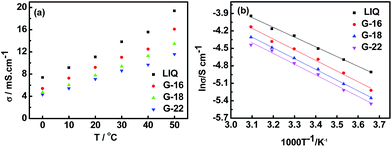 | ||
Fig. 5 (a) Conductivity of gel electrolyte at various temperatures with 2 wt% gelator, (b) the Arrhenius equation fitting curve of ln![[thin space (1/6-em)]](https://www.rsc.org/images/entities/char_2009.gif) σ vs. 1/T, LIQ: liquid electrolyte. σ vs. 1/T, LIQ: liquid electrolyte. | ||
3.4 Battery performance of the gel electrolyte
Cycling performance of the cells with liquid and gel electrolytes is shown in Fig. 6. The initial discharge curves at 0.1C are shown in Fig. 6a. All cells showed stable discharge plateau at 3.9 V. The initial charge capacities were 155.8, 141.3, 144.4 and 159.7 mA h g−1 for liquid and gel electrolyte of G-16, G-18 and G-22, respectively, and the corresponding initial discharge capacities were 135.3, 134.4, 134.0 and 133.3 mA h g−1. The discharge capacities were near 134 mA h g−1 for all coin cells, and no obvious difference was observed for the cells with liquid and gel electrolyte.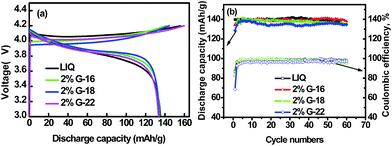 | ||
| Fig. 6 Cycling performance of the LiCoO2/Li coin cells, (a) initial charge/discharge curves, (b) capacity fading and coulombic efficiency during cycling at 0.1C. | ||
The cycling performance was studied at 0.1C and the results are shown in Fig. 6b. After 60 cycles, the discharge capacities were 129.5, 136.8, 134.4 and 134.0 mA h g−1 for liquid and gel electrolyte of G-16, G-18 and G-22, respectively. The capacities did not fade for cells with liquid and gel electrolytes. The coulombic efficiency was simultaneously monitored. The coulombic efficiency of the cells with gel electrolyte of 2 wt% G-16 was quite like that of cells with liquid electrolyte, i.e., the coulombic efficiency reached about 100% at the second cycle. However, the coulombic efficiency of the cells with gel electrolyte of 2 wt% G-18 and G-22 increased at a much lower rate, which reached about 100% in the eighth cycle. The lower coulombic efficiency meant that there were side reactions in the cell system. It is widely accepted that the major factor influencing coulombic efficiency was the growth of SEI layers on anode electrodes.34,35 The slower growth of coulombic efficiency meant that the gel electrolyte might have promoted the formation of SEI layer on anode, which was helpful for the capacity retention.
4. Conclusions
Glutamic acid derivatives with different side chain lengths were synthesized and used as organic gelators to successfully gel commercial electrolyte for lithium ion battery. Gel morphology showed that the glutamic acid derivatives self-assembled to form 3D fibrillar structures with very high porosity. The thermal stability of the gel electrolyte increased with the length of side chain and the concentration of glutamic acid derivatives. Gel electrolyte could broaden the electrochemical window of the liquid electrolyte from 5.03 V to 5.85 V, which would have potential advantage for high voltage lithium ion batteries. Electrochemical impedance spectroscopy results indicated that, although the conductivity decreased a little and activation energy slightly increased, gel electrolyte still showed the conductivity–temperature behavior of liquid electrolyte. The cells with gel electrolyte showed similar cycling performance as those with liquid electrolyte, which indicated that the organic gelator of glutamic acid derivatives could be used in lithium ion batteries, especially in high voltage lithium ion batteries.Acknowledgements
The authors appreciate the support from the Natural Science Foundation of China (Grant No. 21434003), the National High Technology Research and Development Program of China (863) (Grant No. 2015AA033801), the Fundamental Research Funds for the Central Universities, and the Program for Changjiang Scholars and Innovative Research Team in University.References
- M. M. Thackeray, C. Wolverton and E. D. Isaacs, Energy Environ. Sci., 2012, 5, 7854–7863 CAS.
- G. Jeong, Y. U. Kim, H. Kim, Y. J. Kim and H. J. Sohn, Energy Environ. Sci., 2011, 4, 1986–2002 CAS.
- N. S. Choi, Z. Chen, S. A. Freunberger, X. Ji, Y. K. Sun, K. Amine, G. Yushin, L. F. Nazar, J. Cho and P. G. Bruce, Angew. Chem., Int. Ed., 2012, 51, 9994–10024 CrossRef CAS PubMed.
- Y. K. Sun, D. H. Kim, C. S. Yoon, S. T. Myung, J. Prakash and K. Amine, Adv. Funct. Mater., 2010, 20, 485–491 CrossRef CAS.
- S. Wang, L. Lu and X. Liu, J. Power Sources, 2013, 244, 101–108 CrossRef CAS.
- D. D. MacNeil and J. R. Dahn, J. Electrochem. Soc., 2001, 148, A1211–A1215 CrossRef CAS.
- H. Jia, P. Gao, J. Yang, J. Wang, Y. Nuli and Z. Yang, Adv. Energy Mater., 2011, 1, 1036–1039 CrossRef CAS.
- Y. S. Kim, Y. G. Cho, D. Odkhuu, N. Park and H. K. Song, Sci. Rep., 2013, 3, 1917 Search PubMed.
- B. Zhang, Q. Wang, J. Zhang, G. Ding, G. Xu, Z. Liu and G. Cui, Nano Energy, 2014, 10, 277–287 CrossRef CAS.
- J. Wang, Z. Hu, X. Yin, Y. Li, H. Huo, J. Zhou and L. Li, Electrochim. Acta, 2015, 159, 61–65 CrossRef CAS.
- K. Xu, Chem. Rev., 2004, 104, 4303–4417 CrossRef CAS PubMed.
- E. M. Erickson, E. Markevich, G. Salitra, D. Sharon, D. Hirshberg, E. de la Llave, I. Shterenberg, A. Rozenman, A. Frimer and D. Aurbach, J. Electrochem. Soc., 2015, 162, A2424–A2438 CrossRef CAS.
- J. Kalhoff, G. G. Eshetu, D. Bresser and S. Passerini, ChemSusChem, 2015, 8, 2154–2175 CrossRef CAS PubMed.
- H. F. Xiang, Q. Y. Jin, C. H. Chen, X. W. Ge, S. Guo and J. H. Sun, J. Power Sources, 2007, 174, 335–341 CrossRef CAS.
- X. Lu and Y. Xu, Solid State Ionics, 2016, 287, 17–21 CrossRef CAS.
- Q. Zhang, J. Pan, P. Lu, Z. Liu, M. W. Verbrugge, B. W. Sheldon, Y. T. Cheng, Y. Qi and X. Xiao, Nano Lett., 2016, 16, 2011–2016 CrossRef CAS PubMed.
- J. Liu, J. Xu, Y. Lin, J. Li, Y. Lai, C. Yuan, J. Zhang and K. Zhu, Acta Chim. Sin., 2013, 71, 869–878 CrossRef CAS.
- W. J. Li, Z. H. Li, C. L. Yang, Q. Z. Xiao, G. T. Lei and Y. H. Ding, RSC Adv., 2016, 6, 47833–47839 RSC.
- H. J. Jiang, Y. Q. Zhang, D. Y. Wu, X. H. Yu and J. H. Cao, Acta Polym. Sin., 2015, 11, 1271–1279 Search PubMed.
- U. Ali, K. J. B. Abd Karim and N. A. Buang, Polym. Rev., 2015, 55, 678–705 CrossRef CAS.
- Y. I. Kang and J. H. Moon, ChemSusChem, 2015, 8, 3799–3804 CrossRef CAS PubMed.
- H. S. Choe, B. G. Carroll, D. M. Pasquariello and K. M. Abraham, Chem. Mater., 1997, 9, 369–379 CrossRef CAS.
- J. H. van Esch and B. L. Feringa, Angew. Chem., Int. Ed., 2000, 39, 2263–2266 CrossRef CAS.
- P. Terech and R. G. Weiss, Chem. Rev., 1997, 97, 3133–3159 CrossRef CAS PubMed.
- Y. Ji, Y. F. Luo, X. R. Jia, E. Q. Chen, Y. Huang, C. Ye, B. B. Wang, Q. F. Zhou and Y. Wei, Angew. Chem., Int. Ed., 2005, 44, 6025–6029 CrossRef CAS PubMed.
- W. Kubo, T. Kitamura, K. Hanabusa, Y. Wada and S. Yanagida, Chem. Commun., 2002, 374–375 RSC.
- Z. Huo, C. Zhang, X. Fang, M. Cai, S. Dai and K. Wang, J. Power Sources, 2010, 195, 4384–4390 CrossRef CAS.
- S. Sun, J. Song, Z. Shan and R. Feng, J. Electroanal. Chem., 2012, 676, 1–5 CrossRef CAS.
- V. R. Basrur, J. Guo, C. Wang and S. R. Raghavan, ACS Appl. Mater. Interfaces, 2013, 5, 262–267 CAS.
- P. Duan and M. Liu, Langmuir, 2009, 25, 8706–8713 CrossRef CAS PubMed.
- H. Xie, Y. Liao, P. Sun, T. Chen, M. Rao and W. Li, Electrochim. Acta, 2014, 127, 327–333 CrossRef CAS.
- J. K. Feng, X. P. Gao, L. J. Ci and S. L. Xiong, RSC Adv., 2016, 6, 7224–7228 RSC.
- A. J. Smith, J. C. Burns, D. Xiong and J. R. Dahn, J. Electrochem. Soc., 2011, 158, A1136–A1142 CrossRef CAS.
- B. Gyenes, D. A. Stevens, V. L. Chevrier and J. R. Dahn, J. Electrochem. Soc., 2015, 162, A278–A283 CrossRef CAS.
- F. M. Wang, H. Y. Wang, M. H. Yu, Y. J. Hsiao and Y. Tsai, J. Power Sources, 2011, 196, 10395–10400 CrossRef CAS.
| This journal is © The Royal Society of Chemistry 2016 |

